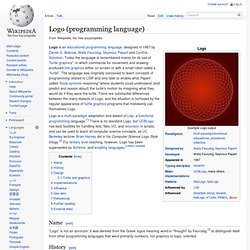

Logo (programming language) "Logo" is not an acronym.

It was derived from the Greek logos meaning word or "thought" by Feurzeig,[3] to distinguish itself from other programming languages that were primarily numbers, not graphics or logic, oriented. Logo is generally known as an interpreted language, although recently there have been developed compiled Logo dialects—such as Lhogho or Liogo. Logo is not case-sensitive but retains the case used for formatting.
It is a compromise between a sequential programming language with block structures, and a functional programming language. Multiple turtles are supported by MSWLogo, as well as 3D graphics. Create your own commands with “learn” The Logo Programming Language. The Logo Programming Language, a dialect of Lisp, was designed as a tool for learning.

Its features - interactivity, modularity, extensibility, flexibility of data types - follow from this goal. Interactivity Although there are some versions of Logo that compile, it is generally implemented as an interpreted language. The interactivity of this approach provides the user with immediate feedback on individual instructions, thus aiding in the debugging and learning process. Introduction. What is Arduino?

Arduino is a tool for making computers that can sense and control more of the physical world than your desktop computer. It's an open-source physical computing platform based on a simple microcontroller board, and a development environment for writing software for the board. Arduino can be used to develop interactive objects, taking inputs from a variety of switches or sensors, and controlling a variety of lights, motors, and other physical outputs. Massimo Banzi: How Arduino is open-sourcing imagination.